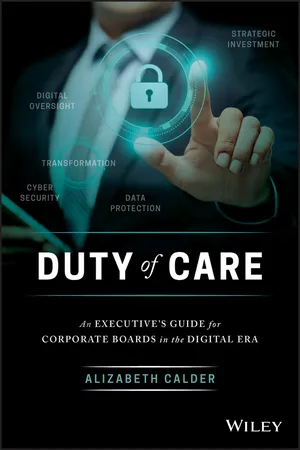
Duty of Care
An Executive's Guide for Corporate Boards in the Digital Era
Alizabeth Calder
- English
- ePUB (mobile friendly)
- Available on iOS & Android
Duty of Care
An Executive's Guide for Corporate Boards in the Digital Era
Alizabeth Calder
About This Book
An essential guide for board members and executives who need to understand the impact of digital on their thinking and decision making
Duty of Care: An Executive's Guide for Corporate Boards in the Digital Era offers a much needed guide for board directors and leaders who need to get up-to-speed and close their digital knowledge gap in order to make the right decisions about digital technology investment and deployments. Written in easy-to-read language, this book targets directors and executives who want to protect themselves from risks ranging from massive cyber security breaches to digital infrastructure investment mistakes.
Most board members don't have the information they need to understand digital information systems, modern high-speed networks, and rapidly evolving software and hardware ecosystems. They also don't have the time to seek out or filter what they need from the many diverse sources. Their lack of knowledge can lead to disastrous decisions that can cost shareholders billions of dollars in lost income or risk liability. Written by a globally recognized experienced business executive and expert in cyber security, this essential guide and blueprint can serve the strategic and governance needs of every company.
- Written by an noted expert in cyber security and digital strategy
- Designed to be accessible for board members unfamiliar with digital technology, with case studies and smart questions to support leaders on every topic
- Helps board directors, corporate officers, and corporate investors with the digital knowledge needed to make informed decisions
Duty of Care is a comprehensive yet accessible book that helps board members close their "digital knowledge gap" in order to better serve their corporations.
Frequently asked questions
Chapter 1
Basics and Essentials

- Not everything discussed will be relevant for you, but you should understand all the concepts. If you don't know that a technology exists and what it can do, how will you know when to consider it?
- Many technologists thrive on being opaque. They use overly complicated words. Do not let unfamiliar words stop you from understanding.
- Your IT leaders are setting strategy with the tactical decisions they make every day. Your company may have to live with those decisions for a long time, and they may dramatically limit the options that you have. You need to set the direction, so the tactical decisions are aligned and enabling.


Social Engagement
- Consumption – You should know how many people view or download your content.
- Sharing – You should know if the content you are putting out there is gaining momentum.
- Lead Generation – You should know exactly how your content is generating leads, or creating real interest in making a purchase.
- Conversion to Sales – You should know what specific content drives sales, and you should be measuring the monetary value of those sales.
- Fitbit is an example of a wearable device that helps people improve their health and lifestyle by using sensors to track and report on activity levels.
- Users of Fitbit also use the Fitbit app. They can invite their fit-focused friends to join a group, making their fitness activity a shared lifestyle. By encouraging fitness enthusiasts to challenge each other through the app, Fitbit created a game that could be shared by socially connected communities. That use of gamelike features to improve engagement is called gamification.
- Bing, Yelp, and Yahoo are examples of companies transforming their business model using geo-fencing, which is the creation of a virtual perimeter that represents a real-world geographic area. When you are online, and your computer asks if it can identify your current location, the site you are using is applying geo-fencing to be more relevant for you. On a mobile device, apps dynamically make shopping and dining recommendations that are specific to exactly where you are at the time.
- Retailer Urban Outfitters saw a 75% increase in sales by tracking customer devices in the store and then sending offers tied directly to the section of the store that the customer was in.2
- Our earlier Burberry example took social media engagement to new heights by talking to customers real-time and getting those customers to share their shopping with social media friends. Engagement worked – customers bought more.
- International airports are leveraging the most powerful strategic “social” tool so far – personalization. By knowing that the app user is in the airport, and offering faster check-in or automated customs processing, airports now provide offers that are uniquely relevant to the person, the place, and the time. This self-focused trend is also known as the Internet-of-Me.
- By 2018 over 50% of companies will redirect investments toward customer experience innovation. Source: Gartner
- Eighty-one percent of consumers want brands to understand them better and know when and when not to approach them. Source: Accenture
- Sixty percent of marketers struggle to personalize content in real time, yet 77% believe real-time personalization is crucial. Source: Adobe